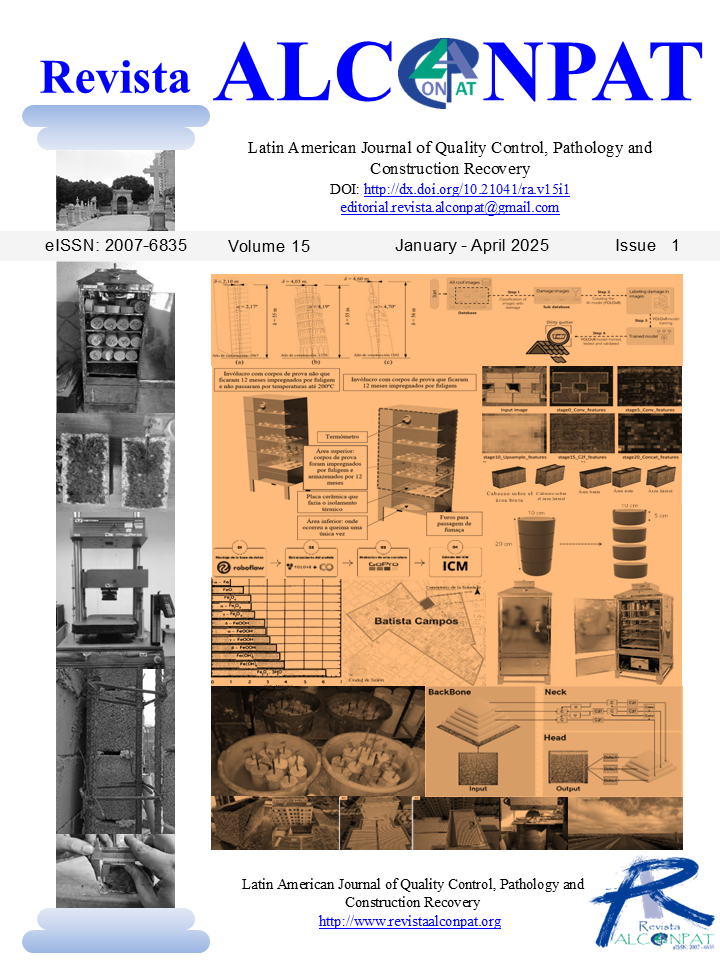Evaluation of the carbonated front in concrete samples subjected to non-regular wetting-air drying cycles
DOI:
https://doi.org/10.21041/ra.v15i1.732Keywords:
reinforced concrete, carbonation, corrosion, durabilityAbstract
The objective of this research is to experimentally evaluate how certain characteristics of the concretes under study influence the carbonation phenomenon. To do this, concretes are prepared with three w/c ratios, two types of cement, and with the incorporation of a water-repellent additive, then exposed to air-drying and wetting for a period of 6 years. From the results obtained, the correspondence of the advance of the carbonate front with the tensile strength was observed, as well as its dependence on the design characteristics and the particularities of the exposure condition.
Downloads
References
Behnood, A., Van Tittelboom, K., De Belie, N. (2016), Methods for measuring pH in concrete: A review”. Construction and Building Materials, 105, 176-188.
https://doi.org/10.1016/j.conbuildmat.2015.12.032
Broomfield, J. P. (2023), Corrosion of steel in concrete: understanding, investigation and repair. Crc Press. https://doi.org/10.1201/9781003223016
Castro, P., Sanjúan, M., Genescá, J. (2000), Carbonation of concretes in the Mexican Gulf. Building and Environment 35, 145-149. doi.org/10.1016/S0360-1323(99)00009-8
CIRSOC 201 (2005), Reglamento Argentino de Estructuras de Hormigón. INTI, Argentina. https://www.inti.gob.ar/assets/uploads/files/cirsoc/vigencia-013/area100/area100a/reglamento201completo.pdf
Dal Molin, D. (1988), “Fissuras en estructuras de concreto armado: Análisis das manisfetacoes típicas e levantamento de casos ocorridos no Estado do Rio Grande do Sul”, Universidad Federal de Rio Grande do Sul, Porto Alegre, Brasil.
De Medeiros, M., Raisdorfer, J., Hoppe Filho, J., Medeiros-Junior, R. (2017). Partial replacement and addition of fly ash in Portland cement: influences on carbonation and alkaline reserve. Journal of Building Pathology and Rehabilitation, 2, 1-9. https://doi.org/10.1007/s41024-017-0023-z
Di Maio, A., Sota, J., Traversa, L. (1999), “Patología de estructuras de hormigón. Análisis de algunos casos más relevantes ocurridos en la Argentina en los últimos años”, III Congreso Iberoamericano de Patología de la Construcción y V Congreso Iberoamericano de Control de Calidad, La Habana, Cuba.
Guzmán, M., Maldonado, G., Giolo, E. (2018), Evaluación de la resistividad eléctrica del hormigón como parámetro de durabilidad frente a la corrosión del acero, XXXVIII Jornadas Sudamericanas de Ingeniería Estructural, Lima, Perú.
Guzmán, M., Maldonado, G., Roldan, V., Acosta, S., Dagne, C. (2019), END para la valoración cualitativa del proceso corrosivo en probetas de hormigón armado con distintas características de diseño, XII Congreso Regional de Ensayos No Destructivos y Estructurales CORENDE, Buenos Aires, Argentina.
Guzmán, A. (2023), Umbrales de resistividad para evaluar durabilidad del hormigón con hidrofugantes y diferentes relaciones agua/cemento. Revista ALCONPAT, 13(3), 286-298. doi.org/10.21041/ra.v13i3.699
Houst, Y., Wittmann, F. (2002), Depth profiles of carbonates formed during natural carbonation. Cement and Concrete Research 32, 1923-1930. https://doi.org/10.1016/S0008-8846(02)00908-0
Instituto Argentino de Normalización y Certificación (1995), IRAM 1658: Determinación de la resistencia a la tracción simple por compresión diametral. Buenos Aires, Argentina, IRAM. https://www.iram.org.ar/
Instituto Argentino de Normalización y Certificación (2000), IRAM 50000: Cemento para uso general. Buenos Aires, Argentina, IRAM. https://www.iram.org.ar/
Instituto Argentino de Normalización y Certificación (2004), IRAM 1534: Hormigón. Preparación y curado de probetas en laboratorio para ensayos de compresión y de tracción por compresión diametral. Buenos Aires, Argentina, IRAM. https://www.iram.org.ar/
Instituto Argentino de Normalización y Certificación (2022), IRAM/IAS U 500-528: Barras de acero conformadas de dureza natural, para armadura en estructura de hormigón. Buenos Aires, Argentina, IRAM. https://www.iram.org.ar/
Irassar, E. (2001), Durabilidad del hormigón estructural, XIV Reunión Técnica de la Asociación Argentina de Tecnología del Hormigón y Seminario de Durabilidad del Hormigón Estructural, Olavarría, Buenos Aires, Argentina.
Leemann, A., Nygaard, P., Kaufmann, J., Loser, R. (2015). Relation between carbonation resistance, mix design and exposure of mortar and concrete. Cement and Concrete Composites 62, 33-43. https://doi.org/10.1016/j.cemconcomp.2015.04.020
Marcotte, T. (2001), Characterization of chloride-induced corrosion products that form in steel-reinforced cementitious materials, PhD Thesis in Mechanical Engineering, University of Waterloo, Waterloo, Canada.
https://uwspace.uwaterloo.ca/bitstream/handle/10012/694/NQ65251.pdf?sequence=1
Priano, C., Señas, L. (2013), Carbonatación de estructuras de hormigón ubicadas en ambiente urbano y rural. International Journal of Innovation and Applied Studies, 2(1), 6-15.
http://www.issr-journals.org/ijias/
Pu, Q., Jiang, L., Xu, J., Chu, H., Xu, Y., Zhang, Y. (2012), Evolution of pH and chemical composition of pore solution in carbonated concrete. Construction and Building materials, 28(1), 519-524. https://doi.org/10.1016/j.conbuildmat.2011.09.006
Ramachandran, V. S. (1996). Concrete admixtures handbook: properties, science and technology. William Andrew.
https://www.sciencedirect.com/book/9780815513735/concrete-admixtures-handbook
Rao, N., Meena, T. (2017). A review on carbonation study in concrete. IOP Conference Series: Materials Science and Engineering, 263(3), IOP Publishing.
https://iopscience.iop.org/article/10.1088/1757-899X/263/3/032011/pdf
Trocónis, O., Romero, A., Andrade, C., Helene, P., Díaz, I. (1997), Manual de inspección, evaluación y diagnóstico de corrosión en estructuras de hormigón armado. CYTED, Red Temática XV. B. Durabilidad de la armadura, Río de Janeiro, Brasil.
https://repositorio.usp.br/item/000923678
Tuutti, K. (1982), Corrosion of steel in concrete. Swedish Cement and Concrete Research Institute, Stockholm. https://lucris.lub.lu.se/ws/portalfiles/portal/4709458/3173290.pdf
UNE 112-011 (2011), Corrosión en armaduras. Determinación de la profundidad de carbonatación en hormigones endurecidos y puestos en servicio. AENOR, Asociación Española de Normalización y Certificación.
https://www.une.org/encuentra-tu-norma/busca-tu-norma/norma?c=N0047865
Published
How to Cite
Issue
Section
License
_______________________________
License in effect from September 2020
You are free to:
- Share — copy and redistribute the material in any medium or format for any purpose, even commercially.
- Adapt — remix, transform, and build upon the material for any purpose, even commercially.
- The licensor cannot revoke these freedoms as long as you follow the license terms.
Under the following terms:
- Attribution — You must give appropriate credit , provide a link to the license, and indicate if changes were made . You may do so in any reasonable manner, but not in any way that suggests the licensor endorses you or your use.
- No additional restrictions — You may not apply legal terms or technological measures that legally restrict others from doing anything the license permits.
Notices:
You do not have to comply with the license for elements of the material in the public domain or where your use is permitted by an applicable exception or limitation .
No warranties are given. The license may not give you all of the permissions necessary for your intended use. For example, other rights such as publicity, privacy, or moral rights may limit how you use the material.





















.png)














